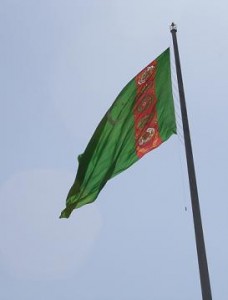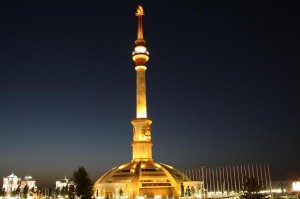Goodbye Turkmenistan
After two months in the arid deserts of Turkmenistan, it is time to move towards water. So we’re setting out sights on the infamous ferry to Azerbaijan from Turkmenbashi.
But as we move on across the Caspian Sea, here is a list of the top things we loved in Turkmenistan:

- Turkmenistan Flag
Merv – The ancient ruins of Merv were astonishing. The dry deserts have preserved the structures yet artifacts remain just sitting on the surface for anyone to admire. Herders push their sheep and camels through 2000 year old doorways and we luckily got to camp in the shadow of Alexander the Great’s biggest capture. Here’s more on Merv.
Darvaza – The flaming crater known as the “Gates of Hell” was a top spot for us, we loved it so much we went back a second time. Nearby, the bubbling mud crater and the languid water crater were also of endless amusement. Camping out next to a gaping, fire-filled hole in the middle of an empty desert is a strange and new experience we wont soon forget! Here’s more.
Nohur – This tiny village tucked away in the mountains between Turkmenistan and Iran houses some of the most ancient of traditions. People lived as they have for hundreds of years, and we sat on a family’s roof and listened to the call to prayer echo off the mountains. Here’s more.
Caspian Sea – Swimming with sea snakes in the Caspian and photographing rusted wreckage, walking around Turkmenbashi and exploring the surrounding area by 4×4- all fun and exciting adventures to be had along the shores of Turkmenistan. Here’s more.
Ashgabat – This city, with its glowing white marble palaces and attempt at building pine forests, will forever be the strangest place we’ve been. It is constantly amusing, and not a moment is left to boredom. Ashgabat is also home to some fun attractions like Independence Park (with a giant, glowing plunger) and the Cableway to the Iranian Border and my favorite, the Push Bazaar. Nearby is Nissa, Geokdepe and an endless dead pine-tree desert.
While there was much more that we got to see and experience, this is just a taste of why we loved Turkmenistan so much.

